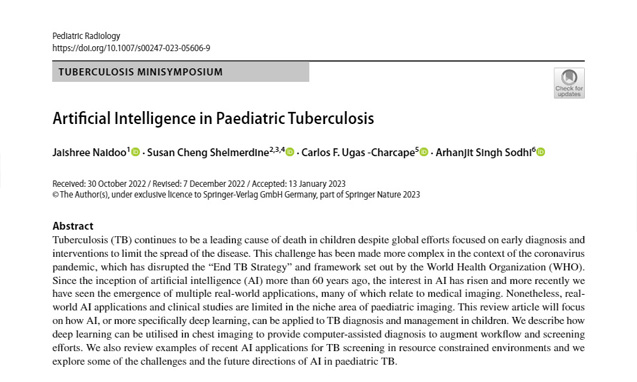WORLD TB DAY 2023: Artificial Intelligence in Paediatric Tuberculosis
Tuberculosis (TB) continues to be a leading cause of death in children despite global efforts focused on early diagnosis and interventions to limit the spread of the disease. This challenge has been made more complex in the context of the coronavirus pandemic, which has disrupted the “End TB Strategy” and framework set out by the World Health Organization (WHO). Since the inception of artificial intelligence (AI) more than 60 years ago, the interest in AI has risen and more recently we have seen the emergence of multiple real-world applications, many of which relate to medical imaging. Nonetheless, realworld AI applications and clinical studies are limited in the niche area of paediatric imaging. This review article will focus on how AI, or more specifically deep learning, can be applied to TB diagnosis and management in children. We describe how deep learning can be utilised in chest imaging to provide computer-assisted diagnosis to augment workflow and screening efforts. We also review examples of recent AI applications for TB screening in resource constrained environments and we explore some of the challenges and the future directions of AI in paediatric TB.

The “2020 Global TB” report revealed that the identification of TB fell by 18% from 2019 to 2020 representing a drop from 7.1 million to 5.8 million estimated diagnoses. This significant reduction during the recent pandemic was due to the reduced capacity to provide adequate screening services because of various lockdowns, as well as restrictions in movement and the associated risks of visiting health care facilities, all of which impacted access to TB diagnosis, testing and treatment [2].
Important progress has been made in improving TB diagnosis in recent decades due to the availability of sensitive bacteriological tests for diagnosis and screening. “Xpert mycobacterium tuberculosis/resistance to rifampicin assay” is a rapid nucleic acid amplification (NAA) test that can detect Mycobacterium tuberculosis as well as drug resistance to rifampicin [3] Although it is a sensitive test, it is costly and requires additional resources including staff and time allocation, especially in paediatrics where obtaining sputum samples can be challenging. Imaging, therefore, plays a critical role in diagnosing pulmonary TB in children, due to their nonspecific clinical manifestations, low bacillary load and the difficulties in obtaining suitable samples [4].
© 2023, Envisionit Deep AI (Pty) Ltd. 2019/038117/07. All Rights Reserved. Terms & Conditions apply.
